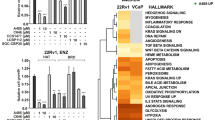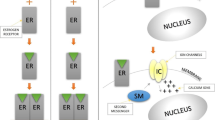Abstract
Although some anti-estrogens have been reported to inhibit the proliferation of prostate cancer cells, few studies on the mechanism by which they suppress the growth of prostate cancer have been reported. We investigated, for the first time, whether anti-estrogens modulate the transactivation activity of the androgen receptor (AR) in prostate cancer cells. In DU-145 cells transfected with AR, the transactivation activity of AR was inhibited by tamoxifen and toremifene, even in the presence of 10 nM of DHT. On the other hand, in LNCaP cells having an endogenous AR mutation at codon 877, the activity of AR was suppressed by faslodex in the presence of 10 nM DHT, whereas it was not inhibited by tamoxifen nor toremifene. In PC-3 cells, both the cell growth and the AR activity were remarkably inhibited by tamoxifen at 50 μM. Faslodex and toremifene inhibited AR activity to some extent, but they seemed to function as agonists at higher concentrations. In PC-3 cells, the inhibition of cell growth by flutamide, faslodex and toremifene was much less than their suppression of AR activity. We also demonstrated that a synthetic estrogen diethylstilbestrol and progesterone-related drugs such as chlormadinone acetate and allylestrenol dose-dependently inhibited the activity of AR in DU-145 and PC-3 cells. These results highlight the anti-androgenic aspect of anti-estrogens and estrogens in regard to the AR-mediated transcription of the relevant genes in prostate cancer.



Similar content being viewed by others
References
Griffiths K, Denis LJ, Behre HE, Bracke M, Krieg M, Kyprianou N, Lee C, Mahler CH, Petritisch P, Prezioso D, Prins GS, Tunn U, Vermeulen A (2000) Estrogens and prostatic disease. Prostate 45: 87
Bonkhoff H, Fixemer T, Hunsicker I, Remberger K (1999) Estrogen receptor expression in prostate cancer and premalignant prostatic lesions. Am J Pathol 155: 641
Kuiper GGJM, Enmark E, Pelto-Huikko M, Nilsson S, Gustafsson J-Å (1996) Cloning of a novel receptor expressed in rat prostate and ovary. Proc Natl Acad Sci U S A 93: 5925
Chang WY, Prins GS (1999) Estrogen receptor-β: implication for the prostate gland. Prostate 40: 115
Lau K-M, LaSpina M, Long J, Ho S-M (2000) Expression of estrogen receptor (ER)-α and ER-β in normal and malignant prostatic epithelial cells: regulation by methylation and involvement in growth regulation. Cancer Res 60: 3175
Latil A, Bieche I, Vidaud D, Lidereau R, Berthon P, Cussenot O, Vidaud M (2001) Evaluation of androgen, estrogen (ERα and ERβ), and progesterone receptor expression in human prostate cancer by real-time quantitative reverse transcription-polymerase chain reaction assays. Cancer Res 61: 1919
Nanni S, Narducci M, Pietra LD, Moretti F, Grasselli A, De Carli P, Sacchi A, Pontecorvi A, Farsetti A (2002) Signaling through estrogen receptor modulates telomerase activity in human prostate cancer. J Clin Invest 110: 219
Raghow S, Hooshdaran MZ, Katiyar S, Steiner MS (2002) Toremifene prevents prostate cancer in the transgenic adenocarcinoma of mouse prostate model. Cancer Res 62: 1370
Huynh H, Alpert L, Alaoui-Jamali MA, Ng CY, Chan TWM (2001) Co-administration of finasteride and the pure anti-oestrogen ICI182,780 act synergistically in modulating the IGF system in rat prostate. J Endocrinol 171: 109
Kim IY, Kim B-C, Seong DH, Lee DK, Seo J-M, Hong YJ, Kim H-T, Morton RA, Kim S-J (2002) Raloxifene, a mixed estrogen agonist/antagonist, induces apoptosis in androgen-independent human prostate cancer cell lines. Cancer Res 62: 5365
Rohlff C, Blagosklonny MV, Kyle E, Kesari A, Kim IY, Zelner DJ, Hakim F, Trepel J, Bergan RC (1998) Prostate cancer cell growth inhibition by tamoxifen is associated with inhibition of protein kinase C and induction of p21 (waf1/cip1). Prostate 37: 51
Bergan RC, Reed E, Myers CE, Headlee D, Brawley O, Cho H-K, Figg WD, Tompkins A, Linehan WM, Kohler D, Steinberg SM, Blagosklonny MV (1999) A phase II study of high-dose tamoxifen in patients with hormone-refractory prostate cancer. Clin Cancer Res 5: 2366
Smith DC, Redman BG, Flaherty LE, Li L, Strawderman M, Pienta KJ (1998) A phase II trial of oral diethylstilbestrol as a second-line hormonal agent in advanced prostate cancer. Urology 52: 257
Weihua Z, Mäkelä S, Andersson LC, Salmi S, Saji S, Webster JI, Jensen EV, Nilsson S, Warner M, Gustafsson J-Å (2001) A role for estrogen receptor β in the regulation of growth of the ventral prostate. Proc Natl Acad Sci U S A 98: 6330
Weihua Z, Lathe R, Warner M, Gustafsson J-Å (2002) An endocrine pathway in the prostate, ERβ, AR, 5α-androstane-3β, 17β-diol, and CYP7B1, regulates prostate growth. Proc Natl Acad Sci U S A 99: 13589
Horvath LG, Henshall SM, Lee C-S, Head DR, Quinn DI, Makela S, Delprado W, Golovsky D, Brenner PC, O’Neill G, Kooner R, Stricker PD, Grygiel JJ, Gustafsson J-Å, Sutherland RL (2001) Frequent loss of estrogen receptor-β expression in prostate cancer. Cancer Res 61: 5331
Leav I, Lau K-M, Adams JY, McNeal JE, Taplin M-E, Wang J, Singh H, Ho S-M (2001) Comparative studies of the estrogen receptors β and α and the androgen receptor in normal human prostate glands, dysplasia, and in primary and metastatic carcinoma. Am J Pathol 159: 79
Fixemer T, Remberger K, Bonkhoff H (2003). Differential expression of the estrogen receptor β (ERβ) in human prostate tissue, premalignant changes, and in primary, metastatic and recurrent prostatic adenocarcinoma. Prostate 54: 79
Torlakovic E, Lilleby W, Torlakovic G, Fossa SD, Chibber R (2002) Prostate carcinoma expression of estrogen receptor-β as detected by PPG5/10 antibody has positive association with primary Gleason grade and Gleason score. Hum Pathol 33: 646
Marcelli M, Weigel NL, Lamb DJ (2000) Steroid receptors in prostate cancer development and progression. In: Ethier SP (ed) Endocrine oncology. Humana, Totowa, p 255
Veldscholte J, Ris-Stalper C, Kuiper GGJM, Jenster G, Berrevoets C, Claassen E, Van Rooij HCJ, Trapman J, Brinkmann AO, Mulder E (1990) A mutation in the ligand binding domain of the androgen receptor of human LNCaP cells affects steroid binding characteristics and response to anti-androgens. Biochem Biophys Res Commun 173: 534
Taplin M-E, Bubley GJ, Ko Y-J, Small EJ, Upton M, Rajeshkumar B, Balk SP (1999) Selection for androgen receptor mutations in prostate cancers treated with androgen antagonist. Cancer Res 59: 2511
Hara T, Miyazaki J, Araki H, Yamaoka M, Kanzaki N, Kusaka M, Miyamoto M (2003) Novel mutations of androgen receptor: a possible mechanism of bicalutamide withdrawal syndrome. Cancer Res 63: 149
Acknowledgements
We thank Dr. Chawnshang Chang, University of Rochester, for providing pSG5AR. We also thank N.V. Organon for the MMTV-Luc reporter plasmid and allylestrenol, the Teikoku Hormone for chlormadinone acetate, and the Nippon Kayaku for flutamide and toremifene. We thank Dr. Henry W. Strobel (University of Texas Medical School, Houston, TX, U.S.A.) for helpful discussions and editing of the manuscript and Ms. Misako Fujimoto for technical assistance. This work was supported in part by grants from the Ministry of Education, Science, and Culture of Japan, and from the Osaka City University Medical Research Foundation.
Author information
Authors and Affiliations
Corresponding author
Rights and permissions
About this article
Cite this article
Kawashima, H., Tanaka, T., Cheng, JS. et al. Effect of anti-estrogens on the androgen receptor activity and cell proliferation in prostate cancer cells. Urol Res 32, 406–410 (2004). https://doi.org/10.1007/s00240-004-0424-8
Received:
Accepted:
Published:
Issue Date:
DOI: https://doi.org/10.1007/s00240-004-0424-8




